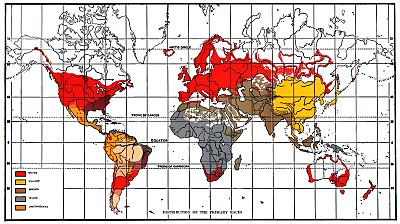The Rising Tide of Color Against White World-Supremacy
 First edition, 1920 | |
| Author | Lothrop Stoddard |
|---|---|
| Language | English |
| Subject | Geopolitics,racial theory |
| Publisher | Charles Scribner's Sons |
Publication date | 1920 |
| Publication place | United States |
| Media type | |
| Pages | 320 (1st edition) |
| OCLC | 1572150 |
| 323.1 | |
| LC Class | HT1521.S7 |
| Part of a series on |
| Eugenics in the United States |
|---|

The Rising Tide of Color: The Threat Against White World-Supremacy(1920), byLothrop Stoddard,is a book aboutracialismandgeopolitics,which describes the collapse ofwhite supremacyandcolonialismbecause of thepopulation growthamongpeople of color,risingnationalismin colonized nations, andindustrializationin China and Japan. To counter the perceived geopolitical threat, Stoddard advocatedNordicism,racial segregation,and generalracism,restricting non-white immigration into white-majority countries, restricting immigration of non-members of the "Nordic race"to countries primarily containing members of the" Nordic race "; restricting Asian migration to Africa; and slowly giving independence to European colonies in Asia (including theMiddle East). A notedeugenicist,Stoddard supported a separation of the "primary races" of the world and warned againstmiscegenation,the mixing of the races.
Publication and reception[edit]
In 1920,The Rising Tide of Color Against White World-Supremacywas positively reviewed and recommended byThe New York Times:"Lothrop Stoddard evokes a new peril, that of an eventual submersion beneathvast waves of yellow men,brown men, black men and red men, whom theNordicshave hitherto dominated... withBolshevismmenacing us on the one hand and race extinction through warfare on the other, many people are not unlikely to give [Stoddard's book] respectful consideration ".[1]
Civil rights activistW. E. B. Du Boisstated "the Nordic peoples...have been responsible for more intermixture of races than any other people, ancient and modern," and in reply to whites' fears of miscegenation declared "Who in Hell asked to marry your daughters?"[1]
In reply to Stoddard's notion that "if the Negroes have separate schools, they shall be good schools; that if they have separate train accommodations, they shall have good accommodations", black audiences allegedly laughed in disbelief.[1]
In 1921, in a speech to a mixed-race audience in Birmingham, Alabama, U.S. PresidentWarren Hardingsaid that Black Americans must have full economic and political rights, but thatsegregationwas also essential to prevent "racial amalgamation" and that social equality was thus a dream that Blacks must give up, and used the book to support his segregationist views: "Whoever will take the time to read and ponder Mr. Lothrop Stoddard’s book onThe Rising Tide of Color...must realize that our race problem here in the United States is only a phase of a race issue that the whole world confronts. "[1]
The anthropologistFranz Boascriticised thescientific racismpresented and advocated inThe Rising Tide of Color,for which racialist advocacy theblack newspapersof the U.S. called Stoddard "the high priest of racial baloney".[1]In the 21st century, the racialism presented by Stoddard remains an ideological influence upon the philosophy and the politics of thewhite supremacistmovement in the United States.[2]
The text is referenced in F. Scott Fitzgerald's novelThe Great Gatsbyby the antagonist Tom Buchanan who states that he has been reading a book by "Goddard" about how the white race will be "utterly submerged".[3]
Synopsis[edit]
Stoddard author claims that there is a perceived threat of non-white "races" to the global dominance of the white race, "typified by theRusso-Japanese War,"which he represents as a struggle of color against white.[4]
In addition toJapanhe describes a "brown reaction", which he calls "theMohammedanRevival ",[5]taking as exemplary Yahya Siddyk's work "The Awakening of the Islamic Peoples in the Fourteenth Century of the Hegira".[6]He also describes in Africa a movement he calls the "Ethiopian Church",spread by" Afro-AmericanMethodistpreachers ", and" having had a hand in theZulu risingwhich broke out inNatalin 1907 ".[7]
The book also warns of the dangers of race mixing and the need for white countries to maintain their racial "purity". The thesis is that due toimmigration,white people produce fewer children so as to give them the capital to live in white communities:
"As long as the people of any community are relatively homogeneous, what differences of wealth and social position there may be do not affect the birth-rate, or do so only after a considerable time. But put into that community a number of immigrants, inferior mentally, socially, and economically, and the natives are unwilling to have their children associate with them in work or social life. They then limit the number of their children in order to give them the capital or education to enter occupations in which they will not be brought into contact with the new arrivals."[8]
Stoddard argues that the increasing population and economic power of non-white races, particularly in Asia, will lead to a "collapse of civilization", typified by the situation inLatin America,which he describes as "themongrel's political ascendancy ", saying further that" [t]hese unhappy beings, every cell of whose bodies is a battle-ground of jarring heredities, express their souls in acts of hectic violence and aimless instability. The normal state of tropical America is anarchy, restrained only by domestic tyrants or foreign masters ".[9]Stoddard's thesis is that the white race has dominated world affairs for centuries and has created a civilization that is superior to all others.
See also[edit]
References[edit]
- ^abcdeFrazier, Ian(2019-07-26)."When W. E. B. Du Bois Made a Laughingstock of a White Supremacist".The New Yorker.Retrieved2019-08-30.
- ^Berlet, Chip;Vysotsky, Stanislav (2006)."Overview of U.S. White Supremacist Groups".Journal of Political and Military Sociology.34(1): 14.
- ^Crean, Jeffrey (2024).The Fear of Chinese Power: an International History.New Approaches to International History series. London, UK:Bloomsbury Academic.p. 47.ISBN978-1-350-23394-2.
- ^Stoddard, Lothrop (1921).The Rising Tide of Color.p. 12.
- ^Stoddard 1921,p. 57.
- ^Stoddard 1921,p. 62.
- ^Stoddard 1921,p. 98.
- ^Stoddard 1921,p. 256.
- ^Stoddard 1921,p. 120.
